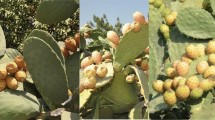Abstract
The composition and quality of edible tender stems or cladodes of 3 Prickly Pear Cactus species (Opuntia amyclaea, O. ficus-indica, and O. inermis) were studied at different stages of development. This traditional Mexican vegetable is called “nopalitos” in Spanish and “cactus leaves” in English. Cladodes harvested when 20 cm in length have the following average composition per 100 g: 91.7 g of water, 1.1 g of protein, 0.2 g of lipid, 1.3 g of ash, 1.1 g of crude fiber, 4.6 g of complex carbohydrates and 0.82 g of simple sugars, 12.7 mg of ascorbic acid and 28.9 µg of carotenes. The cladode's juice has an average pH of 4.6, 0.45% titratable acidity and 6.9% soluble solids. The components which varied most during development of the cladodes were: carotenes, acidity and total carbohydrates which increased, and protein and crude fiber (acid-detergent) which decreased. The nutritive value of the tender cladodes in the stages of growth at which they are commonly harvested and consumed (15 to 25 cm long weighing 50 to 80 g per stem), was similar for the 3 species.
Similar content being viewed by others
References
Acevedo E, Badilla I, Nobel PS (1983) Water relations, diurnal acidity changes, and productivity of a cultivated cactus,O. ficus-indica. Plant Physiol 72: 775–780
Anon (1981) El Nopal. Publicación Especial No. 34. Mexico City: Comisión Nacional de Zonas Aridas e Instituto Nacional de Investigación Forestal, 86 pp
AOAC (1984) Official Methods of Analysis, 14th ed. Washington DC: Association of Official Analytical Chemists, 1141 pp
Barrientos-Pérez F (1965) El nopal y su utilización en México. Rev Soc Mex Historia Natural 26: 87–94
Bicalho UO, Penteado M de VC (1981) Estudo do fruto e do artículo daOpuntia ficus-indica (L.) Miler cultivada em Valinhos SP I. Characterísticas bromatológicas. Rev Farm Bioquim Univ S Paulo 17(1): 93–101
Bravo-Hollis H (1978) Las Cactáceas de México. Mexico City: UNAM, pp 62–83
Camarillo B, Grajeda JE (1979) Estudio comparativo de cinco selecciones de nopal para consumo humano. Proc Trop Reg Amer Soc Hort Sci 23: 236–238
Feitosa-Teles FF (1977) Nutrient analysis of prickly pear (O. ficus-indica, Linn.) Tucson: University of Arizona, PhD dissertation, 157 pp
Feitosa-Teles FF, Stull JW, Brown WH, Whiting FM (1984). Amino and organic acids of the prickly pear cactus (Opuntia ficus-indica L). J Sci Fd Agric 35: 421–425
Gortner WA (1965) Chemical and physical development of the pineapple fruit and plant pigment constituents. J Food Sci 30(1): 30–32
Haard NF (1976) Characteristics of edible plant tissues. In: Fennema OR (ed) Principles of Food Science. Part I. Food Chemistry. New York: Marcel Dekker, pp 41–137
Haytowitz DB, Matthews H (1984) Composition of Foods: Vegetables and Vegetable Products. USDA Agric Handbook No 8–11: 222, 385
Hernández M, Chávez A, Bourges H (1980) Valor nutritivo de los alimentos mexicanos. Publicación L-12, 8th ed Mexico City: Instituto Nacional de la Nutrición, 34p
Montgomery CD (1976) Design and Analysis of Experiments. New York: John Wiley and Sons, 121 pp
Robles-Contreras F (1986) Efecto de la frecuencia de riego sobre las relaciones hídricas, producción y calidad de nopal para verdura (Opuntia ficus-indica). Hermosillo, México: University of Sonora, Professional Thesis, 66 pp
Rodriquez-Felix A (1986) Cambios quimicos y fisiológicos durante el desarrollo de cladodios (nopalitos) de 3 especies deOpuntia. Hermosillo, México: Center for Food Research and Development, MS Thesis, 83 pp
Somogyi M (1952) Notes on sugar determination. J Biol Chem 195: 19–23
Terada M, Watanabe Y, Kunitomo M, Hayashi E (1978) Differential rapid analysis of ascorbic acid and ascorbic acid-2-sulfate by dinitrophenylhydrazine method. Anal Biochem 84: 604–608
Tractenberg S, Mayer AM (1982) Mucilage cells, calcium oxalate crystals and soluble calcium inOpuntia ficus-indica. Ann Bot (London) 50(4): 549–57
Villarreal F, Rojas Mendoza P, Arrellano V, Moreno J (1963) Estudio quimico sobre seis especies de nopales (Opuntia spp). Ciencia 22(3): 59–65.
Author information
Authors and Affiliations
Rights and permissions
About this article
Cite this article
Rodriguez-Felix, A., Cantwell, M. Developmental changes in composition and quality of prickly pear cactus cladodes (nopalitos). Plant Food Hum Nutr 38, 83–93 (1988). https://doi.org/10.1007/BF01092314
Received:
Accepted:
Issue Date:
DOI: https://doi.org/10.1007/BF01092314




